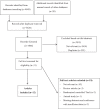The association of dietary insulin load and index with the risk of cancer and cancer mortality: a systematic review and meta-analysis
- PMID: 35673451
- PMCID: PMC9167375
- DOI: 10.1007/s40200-022-01013-3
The association of dietary insulin load and index with the risk of cancer and cancer mortality: a systematic review and meta-analysis
Abstract
Purpose: Insulin levels play an important role in cancer development. However, the link between an insulinogenic diet and cancer is still unclear. Therefore, we performed a systematic review with meta-analysis to investigate the association between dietary insulin index (II) and load (IL) with cancer risk and mortality.
Methods: A comprehensive search between electronic databases (Web of Science, PubMed/Medline, Scopus, and Google Scholar) was conducted to identify relevant studies up to January 2022. The relative risks (RR) and Odds ratios (OR) were extracted from eligible studies, and meta-analysis was performed to calculate the pooled effect size.
Result: 12 papers including 14 studies (10 cohorts and 4 case-control) were included for the meta-analysis. Among them, 10 studies reported effect size for the risk of cancer, and 4 studies reported effect size for cancer mortality. We observed no significant association between II and IL with cancer overall (RRII: 1.03, 95%CI: 0.91-1.17, RRIL: 1.16, 95%CI: 0.94-1.42) and in cohort studies, however, in case-control studies was related with higher odds of cancer (ORII: 2.30, 95%CI: 1.21-4.38, ORIL: 2.57, 95%CI: 1.64-4.02). Higher II and IL scores were associated with the increased risk of total (RRII: 1.29, 95%CI: 1.02-1.63) and (RRIL: 1.39, 95%CI: 1.06-1.83) and colorectal cancer mortality (RRII: 1.29, 95%CI: 1.13-1.48) and (RRIL: 1.37, 95%CI: 1.18-1.60).
Conclusion: Higher dietary II and IL were not associated with cancer risk in overall and cohort studies, whereas related with a higher risk of cancer in case-control studies. We observed a significant positive relation of II and IL with cancer mortality, especially CRC mortality.
Supplementary information: The online version contains supplementary material available at 10.1007/s40200-022-01013-3.
Keywords: Cancer; Cancer mortality; Insulin index; Insulin load; Meta-analysis.
© Springer Nature Switzerland AG 2022.
Conflict of interest statement
Conflict of interestThe authors declare that they have no conflict of interest.
Figures





Similar articles
-
Dietary glycemic index, glycemic load, insulin index, insulin load and risk of diabetes-related cancers: A systematic review of cohort studies.Clin Nutr ESPEN. 2021 Apr;42:22-31. doi: 10.1016/j.clnesp.2021.02.008. Epub 2021 Feb 25. Clin Nutr ESPEN. 2021. PMID: 33745582
-
Dietary acid load and the risk of cancer: a systematic review and dose-response meta-analysis of observational studies.Eur J Cancer Prev. 2022 Nov 1;31(6):577-584. doi: 10.1097/CEJ.0000000000000748. Epub 2022 Mar 8. Eur J Cancer Prev. 2022. PMID: 35307716
-
Dietary glycemic index, glycemic load, and risk of mortality from all causes and cardiovascular diseases: a systematic review and dose-response meta-analysis of prospective cohort studies.Am J Clin Nutr. 2019 Oct 1;110(4):921-937. doi: 10.1093/ajcn/nqz061. Am J Clin Nutr. 2019. PMID: 31187856
-
Adherence to the Mediterranean diet and the risk of lung cancer: a systematic review and dose-response meta-analysis of observational studies.Nutr Rev. 2022 Apr 8;80(5):1118-1128. doi: 10.1093/nutrit/nuab117. Nutr Rev. 2022. PMID: 35224641
-
Fruit and vegetable consumption and risk of depression: accumulative evidence from an updated systematic review and meta-analysis of epidemiological studies.Br J Nutr. 2018 May;119(10):1087-1101. doi: 10.1017/S0007114518000697. Br J Nutr. 2018. PMID: 29759102
Cited by
-
Carbohydrate quality indices and colorectal cancer risk: a case-control study.BMC Cancer. 2023 Apr 17;23(1):347. doi: 10.1186/s12885-023-10786-6. BMC Cancer. 2023. PMID: 37069525 Free PMC article.
-
Colorectal and gastric cancer and its association with dietary patterns in Colombia.Heliyon. 2024 Jul 16;10(14):e34734. doi: 10.1016/j.heliyon.2024.e34734. eCollection 2024 Jul 30. Heliyon. 2024. PMID: 39816338 Free PMC article.
References
-
- Jemal A, Torre LA. The global burden of cancer. The American Cancer SocietyLs principles of oncology: prevention to survivorship. Hoboken: Wiley; 2018. pp. 33–44.
-
- Poirier AE, Ruan Y, Walter SD, Franco EL, Villeneuve PJ, King WD, Volesky KD, O’Sullivan DE, Friedenreich CM, Brenner DR. The future burden of cancer in Canada: long-term cancer incidence projections 2013–2042. Cancer Epidemiol. 2019;59:199–207. - PubMed
-
- López-Suárez A. Burden of cancer attributable to obesity, type 2 diabetes and associated risk factors. Metabolism. 2019;92:136–146. - PubMed
-
- Giovannucci E. Metabolic syndrome, hyperinsulinemia, and colon cancer: a review. Am J Clin Nutr. 2007;86(3):836S–842S. - PubMed
Publication types
LinkOut - more resources
Full Text Sources

